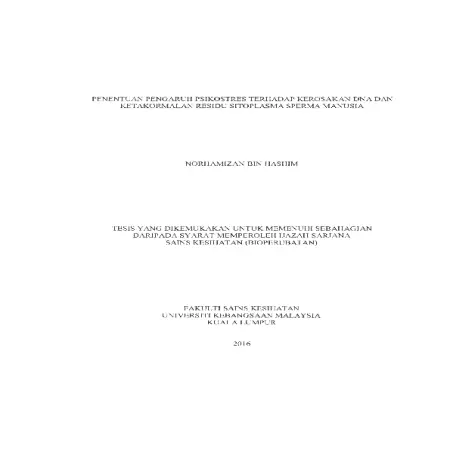Browse by Type
Results for Item type : "Thesis"
|
Autonomy in household decision-making among Malaysia women
Item Type: Thesis
Year: 2022
Abstract: The progress of Malaysian women has significantly improved since 1980, particularly in terms of educational achievement. However, women's labor force participation rate, level of women in decision-making at the household and industry levels, is still below that of men. These instances...[Read More]
|
|
|
|
|
|
The well-being of adolescents in divorced families
Item Type: Thesis
Year: 2020
Abstract: This study aimed to explore an in-depth understanding on the wellness of teenagers in divorced families. This qualitative study used the phenomenological approach to explore the experience of ten teenagers living with single mothers after the divorce of their parents. Participants in...[Read More]
|
|
|
|
|
|
Perkembangan hubungan perkahwinan pasangan kekal berkahwin dalam kitaran perkembangan keluarga
Item Type: Thesis
Year: 2020
Abstract: The developmental perspective is one of the elements taken into account in the development of marital relationships in the family development cycle as it explains the process of transformation encountered by the lasting marriage couples chronologically, before marriage to ageing....[Read More]
|
|
|
|
|
|
Seroprevalence and factors associated with chlamydia trachomatis Infection among subfertile couples attending local public subfertility clinic
Item Type: Thesis
Year: 2020
Abstract: Chlamydia trachomatis is one of the agents that cause the sexually transmitted infections called chlamydia. People practicing risky sexual behaviours such as having multiple sex partners, exercising sexual intercourse at an early age, and undergoing unprotected sexual
intercourse...[Read More]
|
|
|
|
|
|
Fathers' bonding and self-esteem among trainees in the drugs treatment and rehabilitation center in Melaka
Item Type: Thesis
Year: 2018
Abstract: The paper discusses a survey study that examined the father’s bonding and its relationship with self-esteem. A total of 97 trainees in Cure and Care Rehabilitation Centre (CCRC), Tiang Dua, Melaka who participated in the study had responded to questionnaires on aspects of fathers’...[Read More]
|
|
|
|
|
|
Peranan sosialisasi ibu atau bapa komuter dipermudahkan dengan bantuan teknologi gajet dan media sosial: kajian kes di bangunan Ibu Pejabat LPPKN
Item Type: Thesis
Year: 2018
Abstract: This study looks into the role of parents as the socialisation agent for their children in the lives of commuter families, which refers to the parents who do not live with their children due to distance and occupational demands. The rapid development of gadgets and social media...[Read More]
|
|
|
|
|
|
Parenting style and risk level of drug abuse among students in USIM
Item Type: Thesis
Year: 2018
Abstract: Drug issue is a worldwide problem being faced by many countries and creates a complicated social problem including drug abuse among teenagers. This requires an aggressive corrective action by related agencies because it is getting rampant and has yet to be resolved. Nevertheless,...[Read More]
|
|
|
|
|
|
Relationship between family functioning, parenting behaviour, self-efficacy, and gender on risky behaviour amongst adolescents in Kuala Lumpur, Malaysia
Item Type: Thesis
Year: 2018
Abstract: Adolescence is the developmental period marked by a rise in risk-taking behaviours. The high rate of adolescents’ involvement in risky behaviours in the past decades has created a vast amount of attention on the impact to their future. In Malaysia, the impact of risky behaviour has...[Read More]
|
|
|
|
|
|
Kajian bagi mengenalpasti faktor-faktor risiko kanser payudara yang berkaitan dengan gaya hidup dalam kalangan wanita melayu di Kuala Lumpur
Item Type: Thesis
Year: 2016
Abstract: Breast cancer is the most common cancer that has affected women all over the world. The worldwide rates of breast cancer incidence and mortality show a drastic and alarming increase. Until today the cause of the disease has yet to be identified. However, evidences from extensive...[Read More]
|
|
|
|
|
|
Penentuan pengaruh Psikostres terhadap kerosakan DNA dan ketakormalan residu sitoplasma sperma manusia
Item Type: Thesis
Year: 2016
Abstract: Idiopathic infertility has been correlated with psychostress which can result in abnormality and declining semen quality in men. Nevertheless, direct relationship of semen quality and psychostress is still unclear. Hence, this study was conducted to evaluate the effect of...[Read More]
|
|
|
|
|














